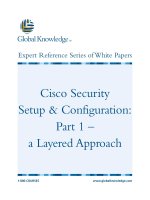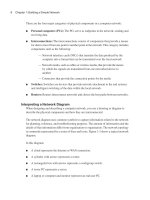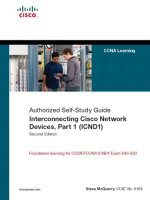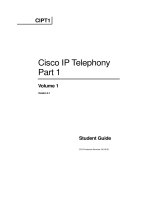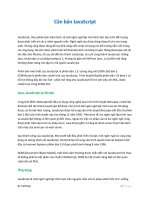Interconnecting Cisco Network Devices, Part 1 (ICND1) docx
Bạn đang xem bản rút gọn của tài liệu. Xem và tải ngay bản đầy đủ của tài liệu tại đây (1.12 MB, 50 trang )
Simpo PDF Merge and Split Unregistered Version -
800 East 96th Street
Indianapolis, Indiana 46240 USA
Cisco Press
Authorized Self-Study Guide
Interconnecting Cisco
Network Devices,
Part 1 (ICND1)
Second Edition
Steve McQuerry,
CCIE No. 6108
Simpo PDF Merge and Split Unregistered Version -
ii
Interconnecting Cisco Network Devices, Part 1 (ICND1)
Second Edition
Steve McQuerry, CCIE No. 6108
Copyright© 2008 Cisco Systems, Inc.
Cisco Press logo is a trademark of Cisco Systems, Inc.
Published by:
Cisco Press
800 East 96th Street
Indianapolis, IN 46240 USA
All rights reserved. No part of this book may be reproduced or transmitted in any form or by any means, electronic or
mechanical, including photocopying, recording, or by any information storage and retrieval system, without written
permission from the publisher, except for the inclusion of brief quotations in a review.
Printed in the United States of America
First Printing December 2007
Library of Congress Cataloging-in-Publication Data:
McQuerry, Steve.
Authorized self-study guide : interconnecting Cisco network devices.
Part 1 (ICND1) / Steve McQuerry. —2nd ed.
p. cm.
Includes index.
ISBN 978-1-58705-462-4 (hbk.)
1. Internetworking (Telecommunication)—Examinations—Study guides. 2. Computer networks—Problems,
exercises, etc. 3. Telecommunications engineers—Certification—Examinations—Study guides. I. Title. II.
Title: Interconnecting Cisco network devices, part 1 (ICND1).
TK5105.5.M3399 2007
004.6—dc22
2007043780
ISBN-13: 978-1-58705-462-4
ISBN-10: 1-58705-462-0
Warning and Disclaimer
This book is designed to provide information about Interconnecting Cisco Network Devices, Part 1 (ICND1). Every
effort has been made to make this book as complete and as accurate as possible, but no warranty or fitness is implied.
The information is provided on an “as is” basis. The authors, Cisco Press, and Cisco Systems, Inc. shall have neither
liability nor responsibility to any person or entity with respect to any loss or damages arising from the information
contained in this book or from the use of the discs or programs that may accompany it.
The opinions expressed in this book belong to the author and are not necessarily those of Cisco Systems, Inc.
Simpo PDF Merge and Split Unregistered Version -
iii
Feedback Information
At Cisco Press, our goal is to create in-depth technical books of the highest quality and value. Each book is crafted
with care and precision, undergoing rigorous development that involves the unique expertise of members from the
professional technical community.
Readers’ feedback is a natural continuation of this process. If you have any comments regarding how we could
improve the quality of this book, or otherwise alter it to better suit your needs, you can contact us through email at
Please make sure to include the book title and ISBN in your message.
We greatly appreciate your assistance.
Corporate and Government Sales
The publisher offers excellent discounts on this book when ordered in quantity for bulk purchases or special sales,
which may include electronic versions and/or custom covers and content particular to your business, training goals,
marketing focus, and branding interests. For more information, please contact:
U.S. Corporate and Government Sales 1-800-382-3419
For sales outside the United States, please contact:
International Sales
Trademark Acknowledgments
All terms mentioned in this book that are known to be trademarks or service marks have been appropriately capitalized.
Cisco Press or Cisco Systems, Inc., cannot attest to the accuracy of this information. Use of a term in this book should
not be regarded as affecting the validity of any trademark or service mark.
Publisher Paul Boger
Associate Publisher Dave Dusthimer
Cisco Representative Anthony Wolfenden
Cisco Press Program Manager Jeff Brady
Executive Editor Brett Bartow
Managing Editor Patrick Kanouse
Development Editor Ginny Bess Munroe
Copy Editor Kevin Kent and Written Elegance, Inc.
Technical Editors Matthew C. Brussel
Tami Day-Orsatti
Kevin Wallace
Editorial Assistant Vanessa Evans
Designer Louisa Adair
Composition ICC Macmillan Inc.
Indexer Tim Wright
Proofreader Water Crest Publishing
Simpo PDF Merge and Split Unregistered Version -
iv
About the Author
Steve McQuerry, CCIE No. 6108, is a consulting systems engineer with Cisco Systems
focused on data center architecture. Steve works with enterprise customers in the
midwestern United States to help them plan their data center architectures. Steve has been
an active member of the internetworking community since 1991 and has held multiple
certifications from Novell, Microsoft, and Cisco. Prior to joining Cisco, Steve worked as an
independent contractor with Global Knowledge, where he taught and developed
coursework around Cisco technologies and certifications.
Simpo PDF Merge and Split Unregistered Version -
v
About the Technical Reviewers
Matthew C. Brussel is currently leading accelerated certification training courses for
Training Camps that specialize in MCSE: Security 2003, MCDST XP, A+, Net+, Security+,
CCNA, CCDA, and others. After studying IT, economics, and accounting in college,
Matthew has been an IT consultant, pre-sales engineer, and IT trainer in various capacities
for over 20 years. He has worked as a traditional trainer and as an accelerated technical
certification boot camp trainer for well over the last 10 years. Matthew also contributes to
custom content and exam prep study guides and participates in various technical writing
and technical editing projects. Previously, Matthew worked as an IT consultant for over
10 years in Portsmouth, RI; Stamford, CT; Greenwich, CT; and New York City. Now
traveling to Training Camp sites all across America, he currently resides in central Florida.
He has over 70 technical certifications and exams to his credit, including Microsoft MCT,
MCSE 2003 with Security and Messaging, CCNA, CCDA, A+, Network+, I-Net+,
Security+, and CTT+ (Written). Matthew can be reached at
Tami Day-Orsatti, CCSI, CCDP, CCNP, CISSP, ECI, EMCPA, MCT, MCSE: 2000/2003
Security, is an IT networking, security, and data storage instructor for T
2
IT Training. She
is responsible for the delivery of authorized Cisco, (ISC)
2
, EMC, and Microsoft classes.
She has over 23 years in the IT industry working with many different types of organizations
(private business, city and federal government, and DoD), providing project management
and senior-level network and security technical skills in the design and implementation of
complex computing environments. She maintains active memberships in local and national
organizations such as (ISC)
2
, ISSA, and SANS.
Kevin Wallace, CCIE No. 7945, is a certified Cisco instructor and a full-time instructor of
Cisco courses. With 18 years of Cisco networking experience, Kevin has been a network
design specialist for The Walt Disney World Resort and a network manager for Eastern
Kentucky University. Kevin holds a bachelor’s of science degree in electrical engineering
from the University of Kentucky. Kevin is also a CCVP, CCSP, CCNP, and CCDP, and he
holds multiple Cisco IP communication and security specializations. Additionally, Kevin
has authored several books for Cisco Press, including CCNP Video Mentor, Voice over IP
First-Step, and Cisco Voice over IP, Second Edition.
Simpo PDF Merge and Split Unregistered Version -
vi
Dedication
This work is dedicated to my family. Becky, as the years go by, I love you more. Thank you
for your support and understanding. Katie, your work ethic has always amazed me. As you
prepare to move into the next phase of your life, remember your goals and keep working
hard and you can achieve anything. Logan, you have never believed there was anything you
couldn’t do. Keep that drive and spirit and there will be no limit to what you can
accomplish. Cameron, you have a keen sense of curiosity that reminds me of myself as a
child. Use that thirst for understanding and learning, and you will be successful in all your
endeavors.
Simpo PDF Merge and Split Unregistered Version -
vii
Acknowledgments
There are a great number of people that go into publishing a work like this, and I would like
to take this space to thank everyone who was involved with this project.
Thanks to the ICND course developers. Most of this book is the product of their hard work.
Thanks to the technical editors, Tami Day-Orsatti, Kevin Wallace, and Matt Brussel, for
looking over this work and helping maintain its technical integrity.
Thanks to all the real publishing professionals at Cisco Press. This is a group of people that
I have had the pleasure of working with since 1998, and it has been a joy and honor. Thanks
to Brett Bartow for allowing me the opportunity to write for Cisco Press once again and to
Chris Cleveland for gently reminding me how to write again after a three-year break. It's
defiantly not as easy as riding a bike. Thanks to Ginny Bess Munroe for keeping the work
flowing and dealing with my bad jokes. Also to Kevin Kent and John Edwards (Written
Elegance), you are the best in the industry.
Thanks to my manager at Cisco, Darrin Thomason, for trusting me to keep all my other
projects managed while working on this project in my spare time. (Wait, do we have spare
time at Cisco?)
Thanks to my customers, colleagues, and former students. Your questions, comments, and
challenges have helped me to continue to learn and helped teach me how to pass that
information to others.
Thanks to my family, for their patience and understanding during this project and all my
projects.
Most importantly, I would like to thank God, for giving me the skills, talents, and
opportunity to work in such a challenging and exciting profession.
Simpo PDF Merge and Split Unregistered Version -
viii
Simpo PDF Merge and Split Unregistered Version -
ix
Contents at a Glance
Foreword xxii
Introduction xxiii
Chapter 1 Building a Simple Network 3
Chapter 2 Ethernet LANs 139
Chapter 3 Wireless LANs 207
Chapter 4 LAN Connections 237
Chapter 5 WAN Connections 345
Chapter 6 Network Environment Management 425
Appendix Answers to Chapter Review Questions 465
Index 480
Simpo PDF Merge and Split Unregistered Version -
x
Contents
Foreword xxii
Introduction xxiii
Chapter 1 Building a Simple Network 3
Chapter Objectives 3
Exploring the Functions of Networking 3
What Is a Network? 4
Common Physical Components of a Network 5
Interpreting a Network Diagram 6
Resource-Sharing Functions and Benefits 7
Network User Applications 9
The Impact of User Applications on the Network 10
Characteristics of a Network 11
Physical Versus Logical Topologies 12
Physical Topologies 12
Logical Topologies 13
Bus Topology 14
Star and Extended-Star Topologies 15
Star Topology 15
Extended-Star Topology 15
Ring Topologies 17
Single-Ring Topology 17
Dual-Ring Topology 18
Mesh and Partial-Mesh Topologies 18
Full-Mesh Topology 18
Partial-Mesh Topology 19
Connection to the Internet 20
Summary of Exploring the Functions of Networking 21
Securing the Network 21
Need for Network Security 22
Balancing Network Security Requirements 25
Adversaries, Hacker Motivations, and Classes of Attack 26
Classes of Attack 27
Mitigating Common Threats 28
Physical Installations 28
Reconnaissance Attacks 29
Access Attacks 30
Password Attacks 30
Summary of Securing the Network 31
References 31
Understanding the Host-to-Host Communications Model 31
OSI Reference Model 32
Layer 7: The Application Layer 34
Simpo PDF Merge and Split Unregistered Version -
xi
Layer 6: The Presentation Layer 34
Layer 5: The Session Layer 35
Layer 4: The Transport Layer 35
Layer 3: The Network Layer 35
Layer 2: The Data Link Layer 35
Layer 1: The Physical Layer 36
Data Communications Process 36
Encapsulation 37
De-Encapsulation 38
Peer-to-Peer Communication 39
The TCP/IP Protocol Stack 40
OSI Model Versus TCP/IP Stack 41
Summary of Understanding the Host-to-Host Communications Model 42
Understanding TCP/IP’s Internet Layer 43
IP Network Addressing 44
IP Address Classes 46
Network and Broadcast Addresses 49
Public and Private IP Addresses 53
Address Exhaustion 54
Dynamic Host Configuration Protocol 58
Domain Name System 58
Using Common Host Tools to Determine the IP Address of a Host 59
Summary of TCP/IP’s Internet Layer 62
Understanding TCP/IP’s Transport and Application Layers 63
The Transport Layer 63
TCP/IP Applications 67
Transport Layer Functionality 67
TCP/UDP Header Format 69
How TCP and UDP Use Port Numbers 72
Establishing a TCP Connection: The Three-Way Handshake 74
Session Multiplexing 77
Segmentation 78
Flow Control for TCP/UDP 78
Acknowledgment 79
Windowing 80
Fixed Windowing 80
Example: Throwing a Ball 80
TCP Sliding Windowing 82
Maximize Throughput 83
Global Synchronization 83
Summary of Understanding TCP/IP’s Transport and Application Layers 83
Exploring the Packet Delivery Process 84
Layer 1 Devices and Their Functions 84
Layer 2 Devices and Their Functions 85
Simpo PDF Merge and Split Unregistered Version -
xii
Layer 2 Addressing 86
Layer 3 Devices and Their Functions 86
Layer 3 Addressing 86
Mapping Layer 2 Addressing to Layer 3 Addressing 87
ARP Table 88
Host-to-Host Packet Delivery 89
Function of the Default Gateway 98
Using Common Host Tools to Determine the Path Between Two Hosts Across a
Network 99
Summary of Exploring the Packet Delivery Process 103
Understanding Ethernet 104
The Definition of a LAN 104
Components of a LAN 105
Functions of a LAN 106
How Big Is a LAN? 107
Ethernet 108
Ethernet LAN Standards 108
LLC Sublayer 109
MAC Sublayer 109
The Role of CSMA/CD in Ethernet 109
Ethernet Frames 111
Ethernet Frame Addressing 112
Ethernet Addresses 113
MAC Addresses and Binary-Hexadecimal Numbers 113
Summary of Understanding Ethernet 114
Connecting to an Ethernet LAN 115
Ethernet Network Interface Cards 115
Ethernet Media and Connection Requirements 116
Connection Media 116
Unshielded Twisted-Pair Cable 118
UTP Implementation 119
Summary of Connecting to an Ethernet LAN 124
Chapter Summary 124
Review Questions 125
Chapter 2 Ethernet LANs 139
Chapter Objectives 139
Understanding the Challenges of Shared LANs 139
Ethernet LAN Segments 140
Extending a LAN Segment 141
Collisions 141
Collision Domains 142
Summary of Ethernet Local-Area Networks 144
Exploring the Packet Delivery Process 144
Layer 2 Addressing 144
Simpo PDF Merge and Split Unregistered Version -
xiii
Layer 3 Addressing 145
Host-to-Host Packet Delivery 145
Summary of Exploring the Packet Delivery Process 150
Operating Cisco IOS Software 151
Cisco IOS Software Features and Functions 151
Configuring Network Devices 152
External Configuration Sources 153
Cisco IOS Command-Line Interface Functions 154
Entering the EXEC Modes 155
Keyboard Help in the CLI 156
Enhanced Editing Commands 159
Command History 160
Summary of Operating Cisco IOS Software 162
Starting a Switch 163
Physical Startup of the Catalyst Switch 163
Switch LED Indicators 164
Viewing Initial Bootup Output from the Switch 166
Logging In to the Switch 168
Configuring a Switch from the Command Line 169
Showing the Switch Initial Startup Status 170
MAC Address Table Management 173
Summary of Starting a Switch 174
Understanding Switch Security 174
Physical and Environmental Threats 175
Configuring Password Security 175
Configuring the Login Banner 177
Telnet Versus SSH Access 178
Port Security Configuration 178
Securing Unused Ports 182
Summary of Understanding Switch Security 182
Maximizing the Benefits of Switching 182
Microsegmentation 182
Example: Getting a Dedicated On-Ramp 183
Duplex Communication 183
Full-Duplex Communication 185
Example: Data Conversations 185
Duplex Interface Configuration 185
Example: Showing Duplex Options 186
Need for Different Media Rates in an Enterprise Network 187
Physical Redundancy in an Ethernet LAN 187
Example: Loops in a Switched Network 189
Loop Resolution with Spanning Tree Protocol (STP) 190
Summary of Maximizing the Benefits of Switching 191
Troubleshooting Switch Issues 191
Simpo PDF Merge and Split Unregistered Version -
xiv
Using a Layered Approach 192
Identifying and Resolving Media Issues 192
Identifying and Resolving Common Access Port Issues 194
Identifying and Resolving Common Configuration Issues 194
Summary of Troubleshooting Switch Issues 194
Chapter Summary 195
Review Questions 195
Chapter 3 Wireless LANs 207
Chapter Objectives 207
Exploring Wireless Networking 207
The Business Case for WLAN Service 207
Differences Between WLANs and LANs 209
Radio Frequency Transmission 210
Organizations That Standardize WLANs 210
ITU-R Local FCC Wireless 211
802.11 Standards Comparison 213
Wi-Fi Certification 214
Summary of Exploring Wireless Networking 215
Understanding WLAN Security 215
Wireless LAN Security Threats 215
Mitigating Security Threats 216
Evolution of Wireless LAN Security 217
Wireless Client Association 218
How 802.1x Works on WLANs 219
WPA and WPA2 Modes 220
Enterprise Mode 220
Personal Mode 221
Summary of Understanding WLAN Security 221
Implementing a WLAN 221
802.11 Topology Building Blocks 222
BSA Wireless Topology 223
Wireless Topology Data Rates 224
Access Point Configuration 226
Steps to Implement a Wireless Network 227
Wireless Clients 227
Wireless Troubleshooting 228
Summary of Implementing a WLAN 229
Chapter Summary 230
Review Questions 230
Chapter 4 LAN Connections 237
Chapter Objectives 237
Exploring the Functions of Routing 238
Simpo PDF Merge and Split Unregistered Version -
xv
Routers 238
Path Determination 239
Routing Tables 240
Routing Table Information 241
Routing Update Messages 241
Static, Dynamic, Directly Connected, and Default Routes 242
Dynamic Routing Protocols 242
Routing Metrics 243
Routing Methods 244
Summary of Exploring the Functions of Routing 246
Understanding Binary Numbering 246
Decimal and Binary Systems 247
Least Significant Bit and Most Significant Bit 248
Base 2 Conversion System 249
Powers of 2 249
Decimal-to-Binary Conversion 250
Binary-to-Decimal Conversion 251
Summary of Understanding Binary Numbering 252
Constructing a Network Addressing Scheme 252
Subnetworks 252
Two-Level and Three-Level Addresses 254
Subnet Creation 254
Computing Usable Subnetworks and Hosts 255
Computing Hosts for a Class C Subnetwork 255
Computing Hosts for a Class B Subnetwork 256
Computing Hosts for a Class A Subnetwork 257
How End Systems Use Subnet Masks 258
How Routers Use Subnet Masks 259
Mechanics of Subnet Mask Operation 261
Applying Subnet Mask Operation 263
Determining the Network Addressing Scheme 264
Class C Example 265
Class B Example 267
Class A Example 268
Summary of Constructing a Network Addressing Scheme 270
Starting a Cisco Router 271
Initial Startup of a Cisco Router 271
Initial Setup of a Cisco Router 272
Logging In to the Cisco Router 279
Showing the Router Initial Startup Status 282
Summary of Starting a Cisco Router 283
Configuring a Cisco Router 283
Cisco Router Configuration Modes 283
Simpo PDF Merge and Split Unregistered Version -
xvi
Configuring a Cisco Router from the CLI 285
Configuring Cisco Router Interfaces 287
Configuring the Cisco Router IP Address 288
Verifying the Interface Configuration 289
Summary of Configuring a Cisco Router 294
Exploring the Packet Delivery Process 295
Layer 2 Addressing 295
Layer 3 Addressing 295
Host-to-Host Packet Delivery 295
Using the show ip arp Command 302
Using Common Cisco IOS Tools 304
Summary of Exploring the Packet Delivery Process 305
Understanding Cisco Router Security 305
Physical and Environmental Threats 306
Configuring Password Security 306
Configuring the Login Banner 307
Telnet and SSH Access 307
Summary of Understanding Cisco Router Security 308
Using the Cisco SDM 309
Cisco SDM Overview 309
Configuring Your Router to Support Cisco SDM 311
Start Cisco SDM 312
More Link 314
Configuration Overview 314
Cisco SDM Wizards 316
Summary of Using the Cisco SDM 317
Using a Cisco Router as a DHCP Server 317
Understanding DHCP 318
DHCPDISCOVER 318
DHCPOFFER 318
DHCPREQUEST 318
DHCPACK 319
Using a Cisco Router as a DHCP Server 319
Using Cisco SDM to Enable the DHCP Server Function 319
Monitoring DHCP Server Functions 321
Summary Using a Cisco Router as a DHCP Server 323
Accessing Remote Devices 323
Establishing a Telnet or SSH Connection 323
Telnet 323
SSH 324
Suspending and Resuming a Telnet Session 325
Closing a Telnet Session 326
Alternate Connectivity Tests 327
Summary of Accessing Remote Devices 329
Simpo PDF Merge and Split Unregistered Version -
xvii
Chapter Summary 329
Review Questions 330
Chapter 5 WAN Connections 345
Chapter Objectives 345
Understanding WAN Technologies 346
What Is a WAN? 346
Why Are WANs Necessary? 348
How Is a WAN Different from a LAN? 348
WAN Access and the OSI Reference Model 350
WAN Devices 350
WAN Cabling 351
The Role of Routers in WANs 353
WAN Data Link Layer Protocols 354
WAN Communication Link Options 355
Summary of Understanding WAN Technologies 356
Enabling the Internet Connection 356
Packet-Switched Communication Links 357
Digital Subscriber Line 358
DSL Types and Standards 359
Cable 360
Global Internet: The Largest WAN 361
Obtaining an Interface Address from a DHCP Server 362
Introducing NAT and PAT 363
Translating Inside Source Addresses 365
Example: Translating Inside Source Addresses 366
Example: Overloading an Inside Global Address 367
Configuring the DHCP Client and PAT 368
Verifying the DHCP Client Configuration 372
Verifying the NAT and PAT Configuration 373
Summary of Enabling the Internet Connection 373
Enabling Static Routing 374
Routing Overview 374
Static and Dynamic Route Comparison 376
Static Route Configuration 376
Example: Understanding Static Routes 376
Example: Configuring Static Routes 378
Default Route Forwarding Configuration 378
Static Route Configuration Verification 379
Summary of Enabling Static Routing 380
Configuring Serial Encapsulation 380
Circuit-Switched Communication Links 381
Public Switched Telephone Network 382
Point-to-Point Communication Links 383
Simpo PDF Merge and Split Unregistered Version -
xviii
Bandwidth 383
Point-to-Point Communication Considerations 385
High-Level Data Link Control Protocol 386
Configuring HDLC Encapsulation 386
Point-to-Point Protocol 387
PPP Layered Architecture 388
Example: PPP Configuration 389
Serial Encapsulation Configuration Verification 390
Frame Relay 391
ATM and Cell Switching 392
Summary of Configuring Serial Encapsulation 394
Enabling RIP 394
Dynamic Routing Protocol Overview 395
Features of Dynamic Routing Protocols 397
Example: Administrative Distance 397
Classful Routing Versus Classless Routing Protocols 398
Distance Vector Route Selection 399
Example: Distance Vector Routing Protocols 400
Example: Sources of Information and Discovering Routes 401
RIP Features 401
RIPv1 and RIPv2 Comparison 402
Dynamic Routing Configuration Tasks 403
RIP Configuration 403
RIP Configuration Verification 404
RIP Configuration Troubleshooting 407
Example: debug ip rip Command 407
Summary of Enabling RIP 407
Chapter Summary 408
Review Questions 409
Chapter 6 Network Environment Management 425
Chapter Objectives 425
Discovering Neighbors on the Network 425
Cisco Discovery Protocol 425
Information Obtained with CDP 426
Implementation of Cisco Discovery Protocol 428
Using the show cdp neighbors Command 428
Monitoring and Maintaining Cisco Discovery Protocol 430
Creating a Network Map of the Environment 432
Summary of Discovering Neighbors on the Network 433
Managing Cisco Router Startup and Configuration 433
Stages of the Router Power-On Boot Sequence 433
Internal Router Components 434
How a Device Locates and Loads Cisco IOS Image and
Configuration Files 437
Simpo PDF Merge and Split Unregistered Version -
xix
Configuration Register 439
Summary of Managing Cisco Router Startup and Configuration 442
Managing Cisco Devices 442
Cisco IOS File System and Devices 443
Managing Cisco IOS Images 445
Managing Device Configuration Files 448
Cisco IOS copy Command 449
Using show and debug Commands on Cisco Devices 452
Summary of Managing Cisco Devices 455
Chapter Summary 455
Review Questions 456
Appendix Answers to Chapter Review Questions 465
Chapter 1 465
Chapter 2 468
Chapter 3 471
Chapter 4 472
Chapter 5 475
Chapter 6 478
Index 480
Simpo PDF Merge and Split Unregistered Version -
xx
Icons Used in This Book
Home OfficeBranch OfficeHeadquartersPC PrinterLaptop
Router Switch
IP Phone
IP
Bridge
IP Telephony
Router
Network Cloud
DSU/CSU
uBR910
Cable DSU
Hub
100BaseT Hub
Repeater
Server Database Host
Access
Server
Access
Point
Modem
Simpo PDF Merge and Split Unregistered Version -
xxi
Command Syntax Conventions
The conventions used to present command syntax in this book are the same conventions
used in the IOS Command Reference. The Command Reference describes these
conventions as follows:
■
Boldface indicates commands and keywords that are entered literally as shown. In
actual configuration examples and output (not general command syntax), boldface
indicates commands that are manually input by the user (such as a show command).
■
Italics indicate arguments for which you supply actual values.
■
Vertical bars (|) separate alternative, mutually exclusive elements.
■
Square brackets [ ] indicate optional elements.
■
Braces { } indicate a required choice.
■
Braces within brackets [{ }] indicate a required choice within an optional element.
Simpo PDF Merge and Split Unregistered Version -
xxii
Foreword
Cisco Certification Self-Study Guides are excellent self-study resources for networking
professionals to maintain and increase internetworking skills and to prepare for Cisco
Career Certification exams. Cisco Career Certifications are recognized worldwide and
provide valuable, measurable rewards to networking professionals and their employers.
Cisco Press exam certification guides and preparation materials offer exceptional—and
flexible—access to the knowledge and information required to stay current in one's field of
expertise, or to gain new skills. Whether used to increase internetworking skills or as a
supplement to a formal certification preparation course, these materials offer networking
professionals the information and knowledge required to perform on-the-job tasks
proficiently.
Developed in conjunction with the Cisco certifications and training team, Cisco Press
books are the only self-study books authorized by Cisco. They offer students a series of
exam practice tools and resource materials to help ensure that learners fully grasp the
concepts and information presented.
Additional authorized Cisco instructor-led courses, e-learning, labs, and simulations are
available exclusively from Cisco Learning Solutions Partners worldwide. To learn more,
visit />I hope you will find this guide to be an essential part of your exam preparation and
professional development, as well as a valuable addition to your personal library.
Drew Rosen
Manager, Learning and Development
Learning@Cisco
November 2007
Simpo PDF Merge and Split Unregistered Version -
xxiii
Introduction
Since the introduction of the personal computer in the early 1970s, businesses have found
more uses and applications for technology in the workplace. With the introduction of local-
area networks, file sharing, and print sharing in the 1980s, it became obvious that
distributed computing was no longer a passing fad. By the 1990s, computers became less
expensive, and innovations such as the Internet enabled everyone to connect to computer
services worldwide. Computing services have become large and distributed. The days of
punch cards and green-bar paper are behind us, and a new generation of computing experts
is being asked to keep this distributed technology operational. These experts are destined
to have a new set of issues and problems to deal with, the most complex of them being
connectivity and compatibility between differing systems and devices.
The primary challenge with data networking today is to link multiple devices' protocols and
sites with maximum effectiveness and ease of use for end users. Of course, this must all be
accomplished in a cost-effective way. Cisco offers a variety of products to give network
managers and analysts the ability to face and solve the challenges of internetworking.
In an effort to ensure that these networking professionals have the knowledge to perform
these arduous tasks, Cisco has developed a series of courses and certifications that act as
benchmarks for internetworking professionals. These courses help internetworking
professionals learn the fundamentals of internetworking technologies along with skills in
configuring and installing Cisco products. The certification exams are designed to be a
litmus test for the skills required to perform at various levels of internetworking. The Cisco
certifications range from the associate level (CCNA), through the professional level
(CCNP), to the expert level (CCIE).
The Interconnecting Cisco Network Devices 1 (ICND1) course is one of two recommended
training classes for CCNA preparation. As a self-study complement to the course, this book
helps to ground individuals in the fundamentals of switches and routed internetworks. It
presents the concepts, commands, and practices required to configure Cisco switches and
routers to operate in corporate internetworks. You will be introduced to all the basic
concepts and configuration procedures required to build a multiswitch, multirouter, and
multigroup internetwork that uses LAN and WAN interfaces for the most commonly used
routing and routed protocols. ICND1 provides the installation and configuration
information that network administrators require to install and configure Cisco products.
This book is the first part of a two-part, introductory-level series and is recommended
for individuals who have one to three years of internetworking experience, are familiar
with basic internetworking concepts, and have basic experience with TCP/IP. While this
self-study book is designed for those who are pursuing the CCNA certification, it is also
useful for network administrators responsible for implementing and managing small- and
Simpo PDF Merge and Split Unregistered Version -
xxiv
medium-sized business networks. Network support staff who perform a help-desk role in a
medium- or enterprise-sized company will find this a valuable resource. Finally, Cisco
customers or channel resellers and network technicians entering the internetworking
industry who are new to Cisco products can benefit from the contents of this book.
Goals
The goals of this book are twofold. First, it is intended as a self-study resource that covers
the subjects on the 640-822 (ICND1) exam as well as the ICND1 material of the 640-802
(CCNA) exam. Second, like the certification itself, the book should help you become
literate in the use of switches, routers, and the associated protocols and technologies. Using
these skills, someone who completes the book and the CCNA certification should be able
to select, connect, and configure Cisco devices in an internetworking environment. In
particular, the book covers the basic steps and processes involved with moving data through
the network using routing and Layer 2 switching.
Readers interested in more information about the CCNA certification should consult the
Cisco website at To schedule a Cisco
certification test, contact Pearson Vue on the web at />Chapter Organization
This book is divided into six chapters and is designed to be read in order because many
chapters build on content from previous chapters.
■
Chapter 1, “Building a Simple Network,” describes the principles on which basic
networks operate. This chapter helps build a foundational understanding that is used
throughout the other chapters of the book.
■
Chapter 2, “Ethernet LANs,” explores the operation and configuration of LANs,
including the challenges associated with these networks, and describes how network
devices are used to eliminate these problems focusing on Layer 2 switching.
■ Chapter 3, “Wireless LANs,” describes how to extend the boundaries of network
connectivity through wireless connectivity. It describes the business drivers and
standards that affect wireless LAN implementation. It also discusses WLAN security
issues and threat mitigation.
NOTE To become CCNA certified, you must pass separate ICND1 and ICND2 exams
or pass a single CCNA exam that tests on the topics from both ICND1 and ICND2.
Simpo PDF Merge and Split Unregistered Version -

